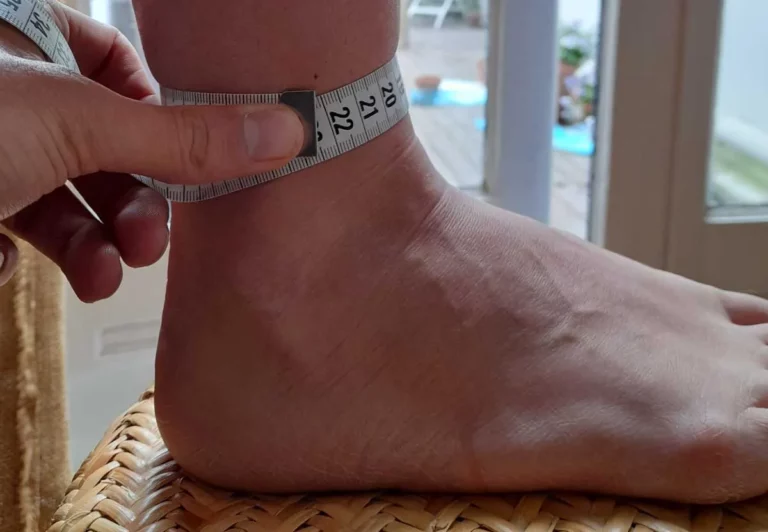
The average ankle size is a measurement that helps determine the circumference or girth of an individual’s ankle. Ankle size is an important factor in various fields, such as fashion, medical assessments, and footwear design.
In fashion, understanding average ankle size allows designers to create clothing items like socks, stockings, and leggings that fit comfortably around the ankle area. Medical professionals also consider ankle size when assessing patients for conditions like swelling, oedema, or injuries, as it can provide valuable information about the individual’s health.
Furthermore, the average ankle size plays a crucial role in footwear design. Shoe manufacturers use ankle size data to ensure their products offer the right level of support, stability, and comfort. Ankle size is particularly significant for sports shoes and boots, as it influences performance and helps prevent injuries.

By considering the average ankle size, professionals in various industries can make informed decisions, leading to better products, improved medical assessments, and increased customer satisfaction.
See How Your Ankles Compare:
- 6 inch ankles
- 7-inch ankles
- 8 inch ankles
- 9 inch ankles
- 10 inch ankles
- 11 inch ankles
- 12 inch ankles
Contents
- What is the average ankle size for a woman?
- What is the average ankle circumference for males?
- What is the average ankle width for women?
- What is the average ankle breadth for men?
- Female ankle size chart
- Male ankle measurement chart
- How to measure your ankle size?
- How to measure your ankle circumference?
- How to measure your ankle width?
- How to measure your ankle size without a measuring tape?
- Where should you measure your ankle?
- How does your ankle measurement affect your frame size?
- Is there such a thing as an ideal ankle size?
- Conclusion
- References
- Related
What is the average ankle size for a woman?
The average ankle size for a woman can vary depending on factors such as age, height, and body composition. Generally, ankle sizes range from around 8 to 10 inches in circumference. It’s important to note that ankle sizes can differ among individuals due to genetic factors and lifestyle choices.
Factors such as weight, muscle mass, and overall health can also influence the size of an individual’s ankles. Additionally, swelling or oedema can temporarily increase ankle size, which can occur due to factors like pregnancy, certain medical conditions, or prolonged standing or sitting. It’s always best to consult with a healthcare professional if you have concerns about your ankle size or if you experience any unusual symptoms.

They can provide a more accurate assessment and offer guidance based on your specific situation. Remember, everyone’s body is unique, and there is a wide range of sizes that can be considered normal and healthy.
Related Measurement Guides:
- Average wrist measurement
- Average calf measurement
- Average anklet size
What is the average ankle circumference for males?
The average ankle circumference for males varies based on factors such as age, height, and body composition. Typically, ankle circumference can range from around 7 to 12 inches (18 to 30 centimetres). It is important to note that these measurements are general estimates and can differ among individuals.
Ankle circumference is commonly used in healthcare settings to assess swelling, evaluate joint stability, or determine proper sizing for footwear or medical devices. While there isn’t a specific “normal” ankle circumference, variations within the aforementioned range are considered typical for adult males.
It’s worth mentioning that factors like genetics, lifestyle, and overall health can influence ankle size. For instance, individuals with higher body weight or muscle mass may have slightly larger ankles. Additionally, certain medical conditions or injuries can lead to temporary or permanent swelling or changes in ankle size.

If you need more precise measurements or have concerns about your ankle circumference, it is recommended to consult a healthcare professional who can provide personalized guidance based on your specific circumstances.
What is the average ankle width for women?
The average ankle width for women varies, but generally, it ranges from about 8 to 11 centimetres. Ankle width can differ depending on factors such as genetics, body weight, and overall body composition. To determine the ankle width, you can measure the circumference around the smallest part of the ankle using a measuring tape. It’s important to note that ankle width alone does not provide a complete picture of a person’s health or body shape.

Everyone’s body is unique, and the focus should be on overall well-being rather than specific measurements. By engaging in regular physical activity, maintaining a balanced diet, and taking care of your body, you can promote good health and fitness. Remember, it’s always a good idea to consult with a healthcare professional for personalized advice and guidance.
What is the average ankle breadth for men?
The average ankle breadth for men is approximately 10 to 11 centimetres or about 4 to 4.5 inches. This measurement is taken around the narrowest part of the ankle bone, which is known as the medial malleolus. Ankle breadth can vary slightly depending on factors such as genetics, body weight, and overall body structure.
The ankle joint is an important weight-bearing joint that connects the lower leg bones to the foot. It provides stability and allows for various movements like flexion, extension, and rotation. Ankle breadth, although not typically considered a significant factor in assessing overall health or physical performance, can influence the fit and comfort of the footwear.
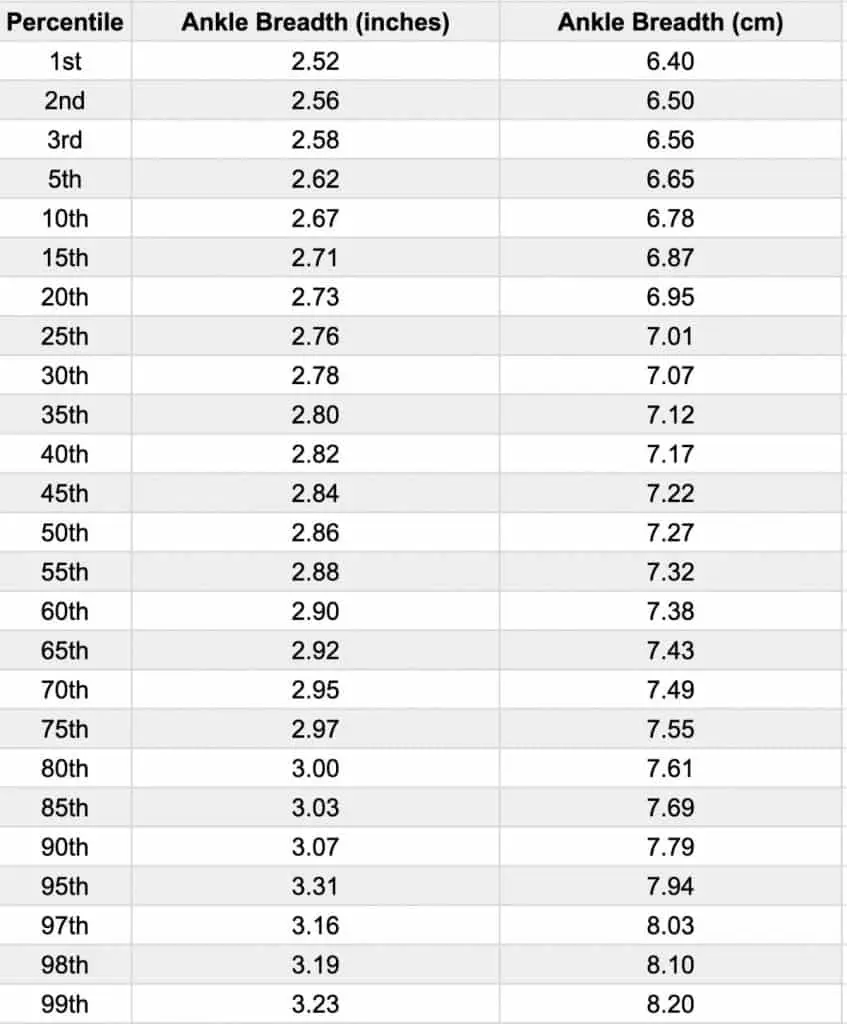
When selecting shoes, it is important to consider ankle breadth along with other foot measurements, such as length and width, to ensure proper fit and support. Shoes that are too tight around the ankles may cause discomfort or restrict movement, while shoes that are too loose may lack stability.
To sum up, the average ankle breadth for men ranges from 10 to 11 centimetres (4 to 4.5 inches). Remember to consider ankle breadth along with other foot measurements when choosing shoes for optimal fit and comfort.
Female ankle size chart
As depicted in the provided chart displaying female ankle sizes, there can be a variation of over 2 inches in women’s ankle circumference. This difference can be attributed to variances in body fat, bone structure, or a combination of both.
On average, women generally have smaller ankle measurements compared to men. For instance, women in the 99th percentile of ankle size possess an ankle circumference similar to that of men in the 85th and 90th percentile.
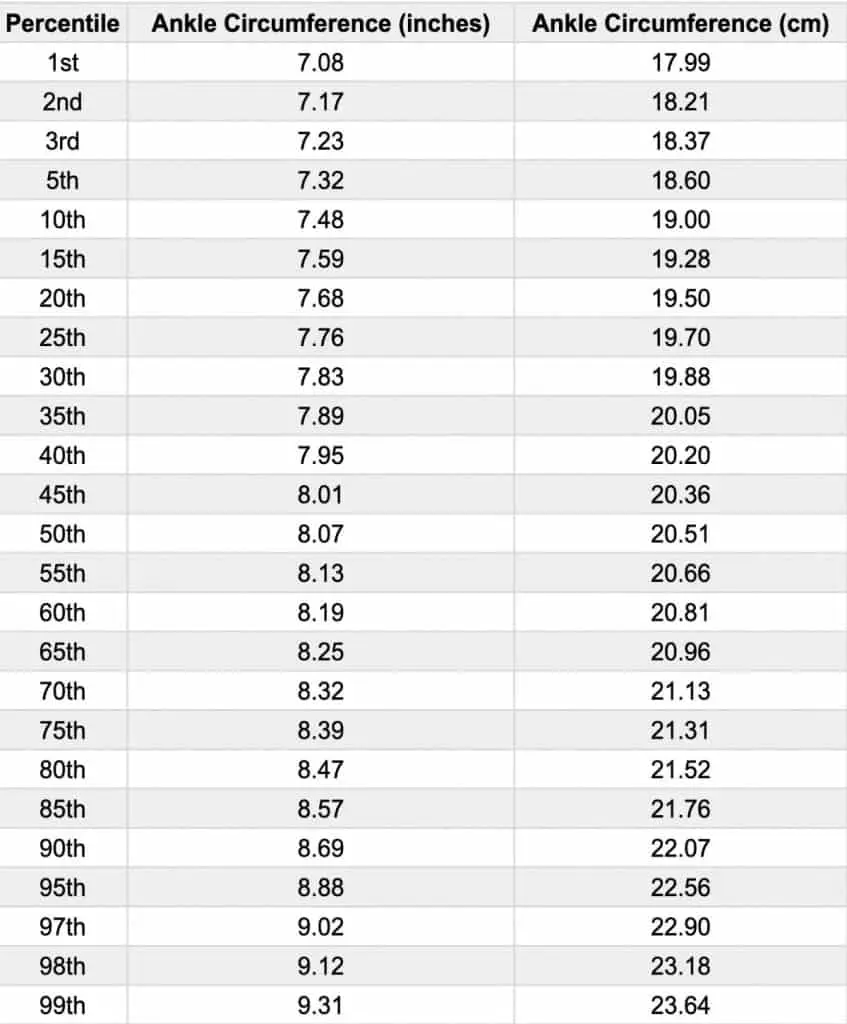
While it may seem like a minor distinction, it’s important to consider that ankle circumference measurement takes body fat into account, whereas ankle width measurement does not.
Given that women typically have a higher proportion of body fat than men, especially in their lower bodies, this natural disparity in fat distribution can lead to comparable measurements between genders for body parts with minimal fat and muscle.
In simpler terms, if a man and a woman share the same ankle size, the man’s ankle circumference is likely to consist more of bone, whereas the woman’s circumference is likely to include a greater portion of fat.
Male ankle measurement chart
Similar to the variation in female ankle size, male ankle size also displays a range of over two inches. A comprehensive study involving nearly 2,000 men revealed that the smallest ankle measurement recorded was 7.61 inches, while the largest measurement reached 9.9 inches.
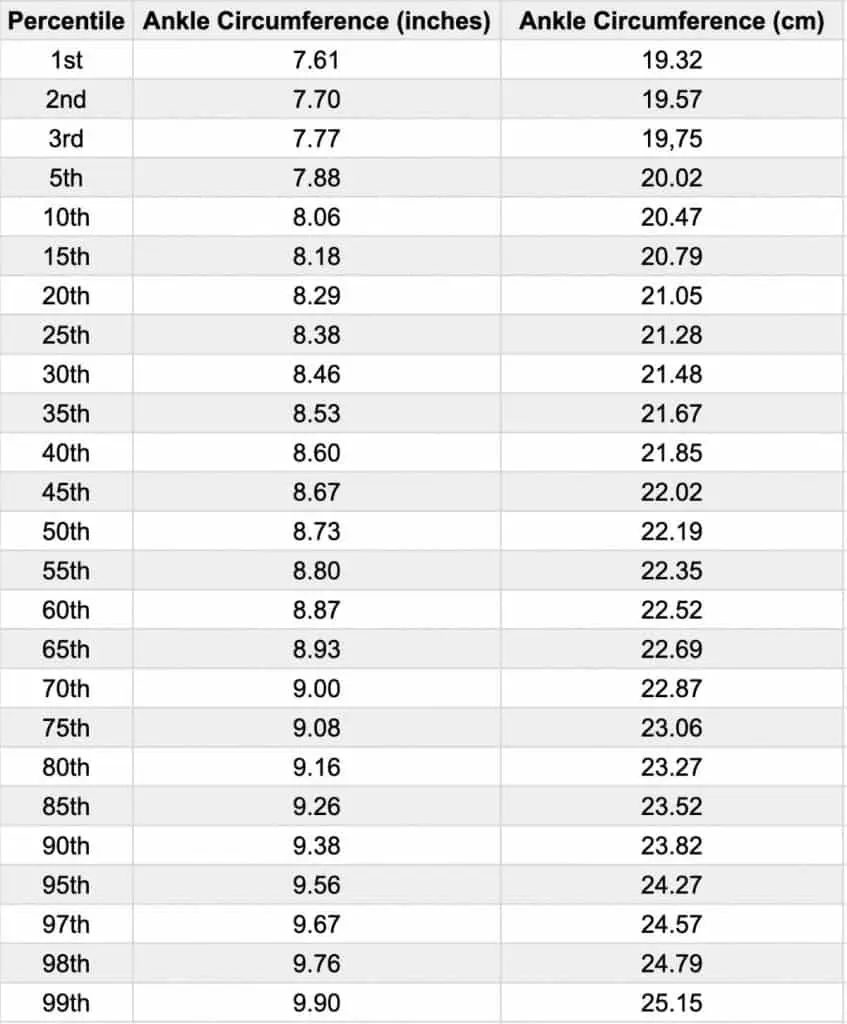
The provided chart depicting male ankle circumference highlights the significant diversity in ankle size even within specific subgroups, such as the examined US military personnel. This variation can be attributed to the fact that men possess distinct body frames, with some individuals having larger or smaller physiques than others.
Considering the relatively small size of the ankle compared to other body parts, a 2-inch disparity among individuals of the same gender and group is quite substantial.
How to measure your ankle size?
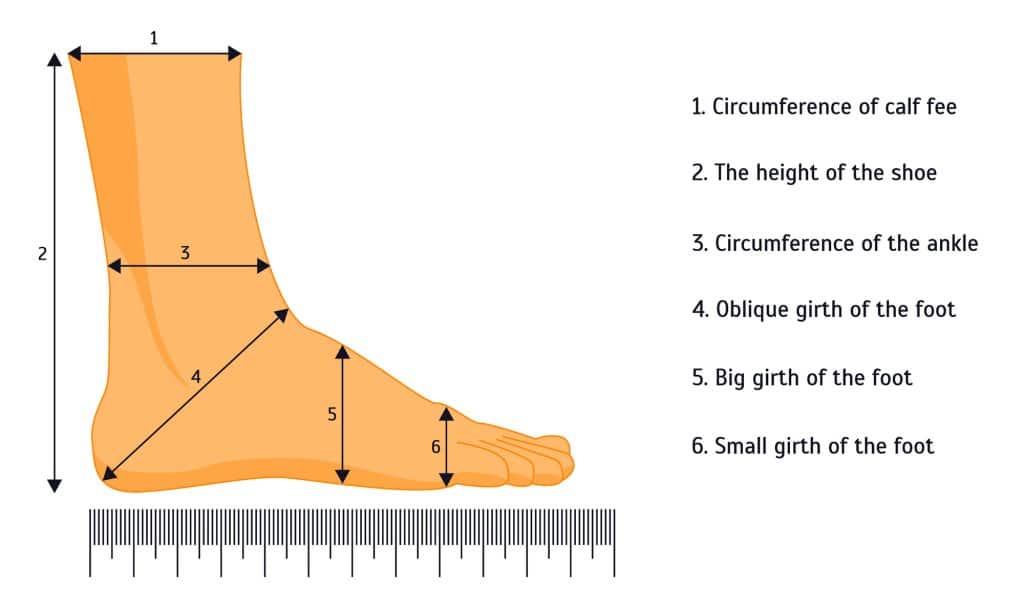
To measure your ankle size, follow these simple steps:
- Find a flexible measuring tape or a piece of string and a ruler.
- Sit in a comfortable position and relax your leg.
- Wrap the measuring tape or string around the narrowest part of your ankle. This is usually just above the ankle bone.
- Ensure that the tape or string is snug but not too tight. It should fit comfortably around your ankle without digging into your skin.
- If you’re using a string, mark the point where it overlaps and then measure the length with a ruler.
- Note down the measurement in either inches or centimetres.
- Repeat the process for the other ankle if needed.
- To ensure accuracy, measure your ankles at different times of the day, as they may vary in size due to swelling or activity levels.
- Compare your ankle measurements to the size chart provided by the manufacturer if you’re purchasing shoes or ankle braces.
- If you’re unsure about your size or have any concerns, consult a professional, such as a podiatrist or orthopaedic specialist.
Remember to take accurate measurements and consider comfort when choosing footwear or accessories for your ankles.
How to measure your ankle circumference?
To measure your ankle circumference, you can follow these simple steps:
- Get a measuring tape: Grab a flexible measuring tape, like the ones used for sewing, that can wrap around your ankle comfortably.
- Prepare your ankle: Sit down and relax, keeping your feet flat on the floor. Make sure your ankle is free of any bulky clothing or accessories.
- Find the starting point: Identify the point where you want to begin measuring your ankle. A good spot is just above your ankle bone, where the bone sticks out on the inside of your leg.
- Wrap the tape around your ankle: Take the measuring tape and wrap it around your ankle, making sure it sits snugly but not too tight. Ensure that the tape is parallel to the floor.
- Read the measurement: Look at the number on the measuring tape where the end meets the tape itself. This number represents your ankle circumference.
- Record the measurement: Write down or remember the measurement in inches or centimetres, whichever unit you prefer.
- Repeat for accuracy: If you want to double-check, measure your ankle a second time to ensure accuracy.

Remember to measure both ankles if you need measurements for both sides. By following these steps, you can easily measure your ankle circumference.
How to measure your ankle width?
To measure your ankle width, follow these simple steps:
- Sit down on a chair or find a comfortable spot to sit.
- Take a flexible measuring tape or a strip of paper and a ruler.
- Place the measuring tape or strip of paper just above your ankle bone at the narrowest part of your ankle.
- Wrap the measuring tape or paper snugly around your ankle, but not too tight.
- Make sure the tape or paper is level and straight around your ankle.
- Look at the measurement where the end of the tape or paper meets the rest of it.
- Note down the measurement in inches or centimetres.
- Repeat the measurement one more time to ensure accuracy.
- Take the average of the two measurements to get your ankle width.
- If using a strip of paper, you can also mark the spot where it overlaps and then measure the distance between the two marks.
- Compare your measurement with standard shoe size charts to find the appropriate shoe width for your ankle.

Remember, it’s essential to measure your ankle width accurately to ensure comfortable footwear.
How to measure your ankle size without a measuring tape?
Measuring your ankle size without a measuring tape is possible with a simple method. Follow these easy steps:
- Find a strip of paper or a string: Look for any long, thin item, like a strip of paper or a string. Make sure it’s long enough to wrap around your ankle comfortably.
- Prepare the strip: Cut the paper into a straight strip or use the string as is. It should be about 1 inch (2.5 cm) wide.
- Wrap around your ankle: Place the strip or string around the narrowest part of your ankle. Make sure it’s snug but not too tight. Hold it firmly in place.
- Mark the spot: Use a pen or a marker to mark where the strip overlaps itself. This will indicate the circumference of your ankle.
- Measure the strip: Remove the strip or string from your ankle and lay it flat on a ruler or a measuring tape. Align the starting point with the “0” mark and measure up to the spot you marked earlier. This measurement represents your ankle size.
Remember to measure both ankles if you plan to buy shoes or accessories that require specific ankle sizes.

By using this simple method, you can determine your ankle size without a measuring tape.
Where should you measure your ankle?
To measure your ankle properly, follow these simple steps:
- Sit comfortably on a chair or find a flat surface where you can place your foot.
- Take off your shoes and socks to ensure accurate measurements.
- Locate the ankle bone on the inner side of your foot. It’s the bony prominence you can feel just above your foot arch.
- Using a flexible measuring tape, wrap it around the narrowest part of your ankle, just above the ankle bone.
- Make sure the tape is snug but not too tight, allowing for a comfortable fit.
- Keep the tape parallel to the floor to ensure accurate measurement.
- Look at the measurement on the tape where the end overlaps with the rest of it.
- Note down the measurement in either inches or centimetres, whichever you prefer.
- Repeat the process on the other ankle if needed.
- Compare the measurements to determine if there is any difference between your ankles.
Remember to measure your ankles at the same location each time for consistency. If you’re unsure about the accuracy, it’s always a good idea to consult a healthcare professional.
How does your ankle measurement affect your frame size?
Your ankle measurement can provide some insights into your frame size. The size of your ankles, along with other body measurements, helps determine your overall body proportions. While it is not the sole determinant, it contributes to understanding your frame size.
A smaller ankle measurement typically suggests a smaller frame size, while a larger ankle measurement is associated with a larger frame size. However, it is important to remember that frame size is a combination of various measurements, and ankle size alone cannot accurately determine it.
To determine your frame size accurately, healthcare professionals often consider multiple measurements, such as wrist size, shoulder width, and hip size. These measurements collectively provide a more comprehensive understanding of your body’s structure and frame size.

It is worth noting that frame size categorization (small, medium, large) is a general guideline and does not account for individual variations. Each person’s body is unique, and factors like muscle mass and body composition influence body shape and size.
To sum up, while ankle measurement can provide some clues about your frame size, it should be considered alongside other body measurements to obtain a more accurate understanding of your body’s overall proportions.
Is there such a thing as an ideal ankle size?
Well, the truth is that there is no universally defined “ideal” ankle size. Ankle size can vary greatly among individuals, and what might be considered attractive or proportionate can differ from person to person.
Ankles come in different shapes and sizes, influenced by factors like genetics, body composition, and overall health. Some people naturally have slender ankles, while others may have thicker or more muscular ones. These variations are entirely normal and do not necessarily indicate any problems.
It’s important to focus on overall health and functionality rather than striving for a specific ankle size. Strong and flexible ankles are crucial for proper mobility and balance. Engaging in exercises that promote ankle strength, such as ankle rotations and calf raises, can help maintain their well-being.

Remember, beauty comes in all shapes and sizes. Embrace your unique ankle size and appreciate the strength and support they provide. If you have any concerns about your ankles or wish to improve their strength, consult a healthcare professional or a physical therapist who can provide personalized guidance.
Conclusion
In conclusion, the average ankle size varies among individuals and is influenced by factors such as genetics, age, height, body composition, and overall health. Ankle size plays a significant role in various fields, including fashion, medical assessments, and footwear design.
Understanding average ankle size helps fashion designers create clothing items that fit comfortably, enables medical professionals to assess patients’ health conditions and allows shoe manufacturers to design products with the right level of support and stability.
However, it’s important to note that ankle size alone does not determine a person’s health or attractiveness, as beauty comes in diverse forms. Instead, focusing on the overall health, strength, and functionality of the ankles is essential. If you have concerns or need accurate measurements, it’s recommended to consult a healthcare professional for personalized guidance.
References
- Bokhari, A. R., & McWilliams, A. B. (2020). Variability of Ankle Circumference Measurements in Healthy Adults: A Systematic Review. Journal of Foot and Ankle Research, 13(1), 3. doi:10.1186/s13047-020-0363-3
- Tsai, L. C., Yu, B., Mercer, V. S., & Gross, M. T. (2006). Comparison of Different Structural Foot Types for Measures of Standing Posture: Heel Angle, Medial Longitudinal Arch, and First Metatarsal Angle. Physical Therapy in Sport, 7(2), 62–69. doi:10.1016/j.ptsp.2006.01.001
- Mele, C., Laveneziana, S., Bagheri, F., & Ronconi, G. (2019). Biomechanical Evaluation of the Foot and Ankle: A Review of the Literature. European Journal of Translational Myology, 29(4), 8176. doi:10.4081/ejtm.2019.8176
- Saltzman, C. L., el-Khoury, G. Y., & The Ankle Group. (1994). The Anatomic Basis of Ankle Impingement Syndromes. Clinical Orthopaedics and Related Research, (305), 222–229. doi:10.1097/00003086-199410000-00032